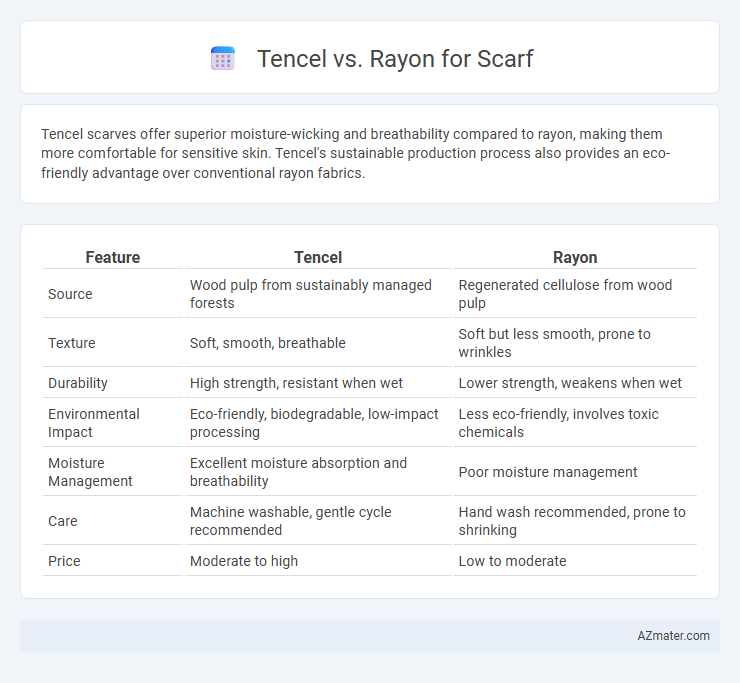Tencel scarves offer superior moisture-wicking and breathability compared to rayon, making them more comfortable for sensitive skin. Tencel's sustainable production process also provides an eco-friendly advantage over conventional rayon fabrics.
Table of Comparison
| Feature | Tencel | Rayon |
|---|---|---|
| Source | Wood pulp from sustainably managed forests | Regenerated cellulose from wood pulp |
| Texture | Soft, smooth, breathable | Soft but less smooth, prone to wrinkles |
| Durability | High strength, resistant when wet | Lower strength, weakens when wet |
| Environmental Impact | Eco-friendly, biodegradable, low-impact processing | Less eco-friendly, involves toxic chemicals |
| Moisture Management | Excellent moisture absorption and breathability | Poor moisture management |
| Care | Machine washable, gentle cycle recommended | Hand wash recommended, prone to shrinking |
| Price | Moderate to high | Low to moderate |
Introduction to Tencel and Rayon
Tencel, derived from sustainably sourced eucalyptus wood pulp, offers exceptional breathability and moisture-wicking properties, making it an eco-friendly and comfortable choice for scarves. Rayon, a semi-synthetic fiber made from regenerated cellulose, provides a smooth texture and vibrant dye retention but has a higher environmental impact due to chemical processing. Both fibers create soft, lightweight scarves, yet Tencel stands out for its sustainability and durability in comparison to traditional rayon materials.
What is Tencel?
Tencel, a brand name for lyocell fiber, is a sustainable fabric derived from eucalyptus wood pulp, known for its eco-friendly production process that uses non-toxic solvents and recycles water. Unlike rayon, which is made from chemically treated cellulose, Tencel fibers are stronger, more breathable, and naturally moisture-wicking, making them ideal for scarves that require softness and durability. Tencel scarves offer superior comfort, hypoallergenic properties, and a silky smooth texture that resists wrinkles and fading over time.
What is Rayon?
Rayon is a semi-synthetic fiber made from regenerated cellulose derived from wood pulp, often used in scarves for its softness and affordability. Unlike Tencel, rayon lacks the sustainable production process and moisture-wicking properties, which can lead to reduced durability and breathability. Its smooth texture makes it comfortable for scarves, but rayon tends to wrinkle easily and may degrade faster with frequent washing.
Production Processes Compared
Tencel is produced through a closed-loop process using sustainably sourced wood pulp, minimizing environmental impact by recycling water and solvents, while rayon involves chemically intensive methods using toxic solvents like carbon disulfide, posing ecological and health risks. The lyocell process for Tencel employs non-toxic solvents, resulting in higher fiber purity and durability, making it more eco-friendly compared to traditional viscose rayon production. Choosing Tencel for scarves ensures a sustainable fabric with efficient resource use and lower emissions during manufacturing.
Environmental Impact
Tencel scarves are produced from sustainably harvested eucalyptus trees using a closed-loop process that recycles water and solvents, significantly reducing environmental pollution compared to conventional Rayon production. Rayon manufacturing often relies on hazardous chemicals like carbon disulfide, which contribute to air and water pollution and pose health risks to workers. Choosing Tencel over Rayon for scarves supports lower ecological footprints through biodegradability, less water consumption, and fewer toxic emissions.
Texture and Comfort
Tencel scarves offer a smooth, silky texture with excellent breathability, making them ideal for sensitive skin and all-day comfort. Rayon scarves, while soft and lightweight, tend to have a slightly heavier feel and may lack the moisture-wicking properties that enhance comfort in Tencel fabrics. Both fabrics provide a luxurious drape, but Tencel's sustainable production and superior softness make it a preferred choice for comfortable, eco-friendly scarves.
Durability and Longevity
Tencel scarves offer superior durability compared to rayon, thanks to their strong cellulose fibers derived from sustainably sourced eucalyptus wood. The fiber's inherent resistance to pilling, stretching, and fading ensures that Tencel scarves maintain their softness and vibrant appearance over prolonged use. Rayon, while soft and breathable, tends to wear out faster due to weaker fibers that are more prone to tearing and color loss under frequent wear and washing.
Breathability and Moisture Management
Tencel scarves exhibit superior breathability and moisture management compared to rayon due to their natural eucalyptus fiber composition, which enhances air circulation and moisture absorption. The lyocell process used in Tencel production creates smooth fibers that wick moisture away from the skin, keeping the wearer dry and comfortable. In contrast, rayon tends to retain moisture and lacks the same level of breathability, making Tencel a preferred choice for scarves in warm or humid conditions.
Style and Color Vibrancy
Tencel scarves maintain exceptional color vibrancy due to their smooth fiber structure, resulting in deep, rich hues that resist fading over time. Rayon scarves offer a wide range of styles with a soft, silky texture, but their colors may dull more quickly after repeated washing. Choosing Tencel ensures a stylish scarf with lasting, vivid colors, making it ideal for maintaining bright and eye-catching accessories.
Which Is Better for Scarves?
Tencel scarves offer superior softness, breathability, and moisture-wicking properties, making them ideal for sensitive skin and all-day comfort. Rayon scarves, while affordable and visually appealing with a smooth texture, tend to be less durable and more prone to shrinking or wrinkling. Choosing Tencel over Rayon ensures a sustainable, eco-friendly option with long-lasting quality and enhanced comfort for scarves.

Infographic: Tencel vs Rayon for Scarf
 azmater.com
azmater.com